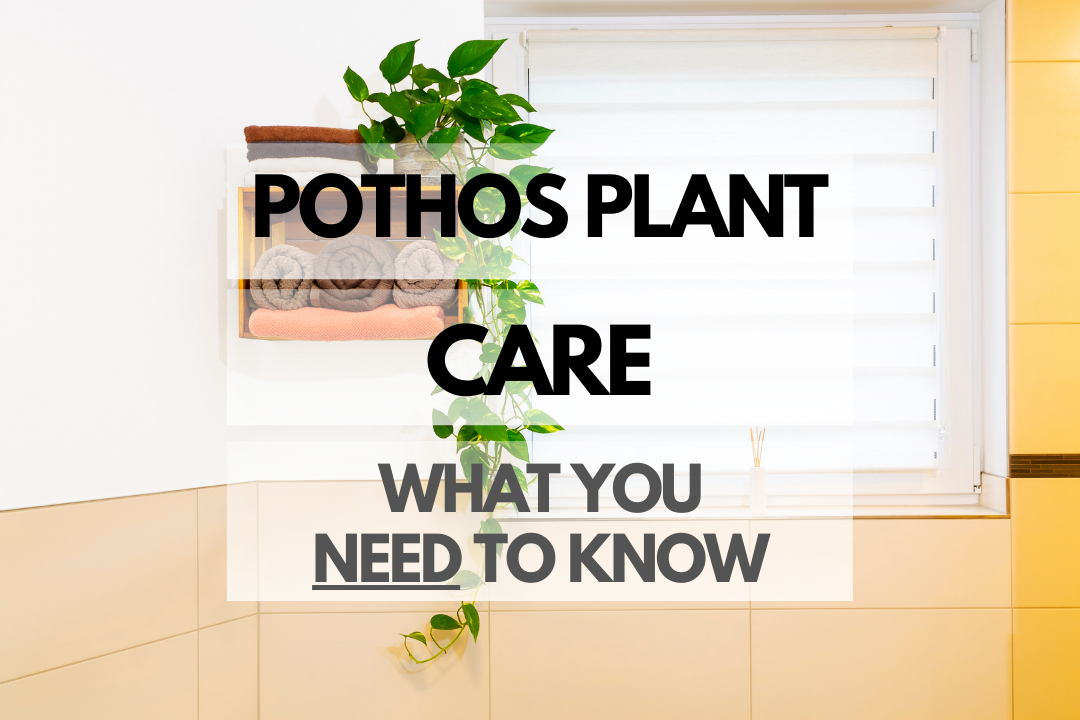Welcome to the wonderful world of Pothos plant care! These versatile and low-maintenance plants are a favorite among houseplant enthusiasts for their hardiness and beautiful trailing foliage. In this guide, we’ll cover everything you need to know to keep your Pothos plant happy and thriving. Let’s dive in!
Pothos Plant Care Guide
Quick Reference Table: Caring for Pothos Plant
| Aspect | Care Instructions |
|---|---|
| Light | Indirect, bright light; can tolerate low light conditions |
| Soil | Well-draining potting mix with perlite or peat moss |
| Watering | Allow soil to dry out between waterings |
| Pruning | Trim as needed to maintain desired shape and size |
| Temperature | 60-80°F (15-27°C); avoid cold drafts and sudden temperature changes |
Pothos Plant Sunlight: Do They Need It and How Much?
Pothos plants do best in bright, indirect sunlight. However, they are also quite adaptable and can tolerate lower light conditions. Be sure to avoid placing your Pothos in direct sunlight, as this can scorch the leaves and cause damage. An east or west-facing window is ideal for providing the perfect amount of light.
Pothos Plant Soil Tips
For a healthy Pothos plant, use a well-draining potting mix with added perlite or peat moss to improve aeration and moisture retention. This will help prevent root rot and ensure that your plant has the right environment for healthy growth.
Pothos Plant Watering and Frequency
Pothos plants prefer to dry out slightly between waterings. To determine when it’s time to water your plant, stick your finger about an inch into the soil. If it feels dry, it’s time to water. Overwatering can lead to root rot, so it’s essential to let the soil dry out before giving your Pothos a drink.
Pruning Pothos Plant Properly
Pruning your Pothos plant helps maintain its shape and size, and encourages fuller growth. To prune, simply trim the vines back to your desired length, cutting just above a leaf node. This will promote new growth and keep your plant looking lush and full.
Optimal Pothos Plant Temperature: Can They Tolerate the Cold?
Pothos plants thrive in temperatures between 60-80°F (15-27°C). They do not tolerate cold drafts or sudden temperature changes well, so it’s important to protect your plant from these conditions. Keep your Pothos away from drafty windows or doors, and avoid placing it near air vents or radiators that could cause temperature fluctuations.
Common Pothos Plant Problems
Yellow Leaves
Yellow leaves on a Pothos plant can be a sign of overwatering. To avoid this issue, make sure you’re allowing the soil to dry out between waterings and using a well-draining potting mix.
Brown Leaf Tips
Brown leaf tips can be caused by a variety of factors, including underwatering, low humidity, or exposure to direct sunlight. To prevent this issue, ensure your Pothos is receiving the proper amount of water, increase humidity around the plant, and protect it from harsh sunlight.
Root Rot
Root rot is often a result of overwatering or poor drainage. To prevent this problem, use a well-draining potting mix, allow the soil to dry out between waterings, and ensure your pot has drainage holes to avoid standing water.
Pothos Plant Outdoors vs. Indoors
Pothos plants can be grown both indoors and outdoors, each with its own set of pros and cons.
| Indoors | Outdoors |
|---|---|
| Adaptable to variouslight conditions | Requires a shaded or partially shaded location |
| Less susceptible to pests and diseases | More prone to pests and diseases |
| Can be grown year-round | May not survive freezing temperatures |
| Ideal for small spaces and hanging pots | Can become invasive in some regions |
Best Pots for Pothos Plant
When choosing a pot for your Pothos plant, the most important factor is drainage. Opt for a pot with drainage holes to prevent water buildup and root rot. Materials like terracotta or ceramic are excellent choices, as they allow the soil to breathe and dry out more evenly. Additionally, consider a pot size that provides enough room for growth but isn’t too large, as Pothos plants prefer to be slightly root-bound.
Pothos Plant Facts
Pothos Plant Benefits
- Air purification: Pothos plants are known to help remove indoor air pollutants such as formaldehyde, benzene, and xylene, making them a great addition to any home or office space.
- Low maintenance: Pothos plants are easy to care for, making them perfect for both experienced and beginner plant enthusiasts.
- Adaptable: Pothos can thrive in various light conditions and are forgiving of occasional neglect, making them a hardy and versatile houseplant choice.
- Decorative: With their trailing vines and lush foliage, Pothos plants add a touch of natural beauty to any indoor space.
Growth Rates: How Fast Do They Grow?
Pothos plants are known for their rapid growth rate. Under ideal conditions, they can grow several feet per year. However, growth rates may vary depending on factors such as light, temperature, and care practices.
Pothos Plant Lifespan
With proper care, Pothos plants can live for many years, often reaching lengths of 10 feet or more. Regular pruning and repotting can help keep your Pothos plant healthy and thriving for an extended period.
Are Pothos Plants Safe?
Pothos plants are considered toxic to pets and humans if ingested, as they contain calcium oxalate crystals. If you have curious pets or children, it’s essential to keep your Pothos out of reach to avoid accidental ingestion.
Pothos Plant Flowers
Although Pothos plants rarely flower indoors, they can produce small, greenish-white flowers in their natural habitat. However, these flowers are insignificant and not the primary attraction of this popular houseplant.
Pothos Plant Types and Varieties
Golden Pothos
Golden Pothos, also known as Devil’s Ivy, is the most common variety and features green leaves with yellow variegation.
Marble Queen Pothos
Marble Queen Pothos has striking green and white marbled leaves, making it an eye-catching addition to any space.
Neon Pothos
Neon Pothos boasts vibrant, neon-green leaves that add a pop of color to any room.
Silver Satin Pothos
Silver Satin Pothos, also known as Silver Philodendron, has silvery-green leaves with a satin-like sheen and dark green veins.
Jade Pothos
Jade Pothos has solid green leaves, making it a classic and elegant choice for any space.
Pothos Plant Pros and Cons
| Pros | Cons |
|---|---|
| Easy to care for | Toxic to pets and humans |
| Air purifying | May require pruning to control growth |
| Adaptable to various light conditions | May become invasive outdoors |
| Attractive trailing foliage | Rarely flowers indoors |
Pothos Plant Cost
Pothos plants are generally affordable, with prices ranging from $5 to $20 or more, depending on factors such as size, variety, and where they’re purchased.
Where to Buy Pothos Plant
Pothos plants are widely available at local garden centers, nurseries, big-box stores, and online retailers. Specialty shops and online marketplaces may offer a wider variety of Pothos types and sizes.
Is Pothos Plant Propagation in Water Possible?
Yes, Pothos plant propagation in water is possible and quite easy. Simply take a cutting with a few leaves and a healthy node, place it in a container of water, and watch as new roots begin to form. Once roots have developed, you can transfer your Pothos cutting to a pot with soil.
Additional Resources
FAQ for Pothos Plant Care
Are Pothos plants toxic to cats?
Yes, Pothos plants are toxic to cats if ingested, causing symptoms such as oral irritation, vomiting, and difficulty swallowing.
Are Pothos plants toxic to dogs?
Yes, Pothos plants are toxic to dogs if ingested, causing similar symptoms as in cats, including oral irritation, vomiting, and difficulty swallowing.
Are Pothos plants toxic to kids?
Pothos plants can be toxic to kids if ingested, causing symptoms such as mouth and throat irritation, difficulty swallowing, and vomiting. It’s essential to keep Pothos plants out of reach of children.
How tall do Pothos plants get?
Pothos plants can grow quite long, often reaching lengths of 10 feet or more. Regular pruning can help control their growth and maintain a desired size.
Can Pothos plants live outside?
Pothos plants can be grown outside in warmer climates, but they may become invasive if not properly managed. In cooler climates, it’s best to grow Pothos plants indoors or move them inside before the first frost.
Are Pothos plants poisonous?
Yes, Pothos plants are considered poisonous due to the presence of calcium oxalate crystals. Ingestion can cause symptoms such as oral irritation, vomiting, and difficulty swallowing in both humans and pets.
In conclusion, Pothos plants are a popular and versatile houseplant choice, known for their air-purifying properties and low-maintenance care requirements. With a variety of types and colors available, there’s sure to be a Pothos plant perfect for any indoor space. Just remember to keep them out of reach from children and pets due to their toxicity.

